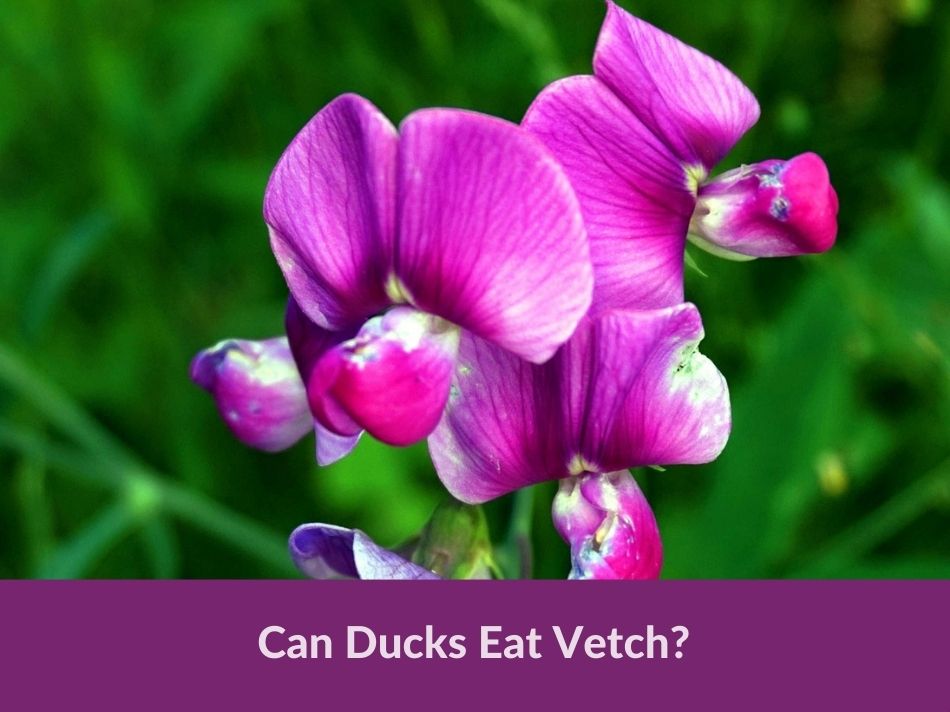Ducks are omnivorous and have a varied diet. In the wild, they consume a mix of aquatic plants, small fish, insects, and even small amphibians. Seeds and grains also form a significant part of their diet. But, can ducks eat vetch?
No, ducks should not eat vetch. Vetch contains vicine and convicine, which can be toxic to ducks. These glycosides can cause hemolytic anemia and favism in ducks.
In this article, we explore the complexities of animal nutrition, focusing on the risks posed by the vetch plant to ducks. We delve into the chemical nature of these compounds, their metabolic implications, and the broader considerations for duck farming.
What Is Vetch?
Vetch refers to several species of the genus Vicia. They are climbing plants with tendrils and are known for their pealike flowers and compound leaves. Vetch is cultivated both as a fodder for animals and as a cover crop in agriculture because of its ability to fix nitrogen in the soil.
The nutritional profile of vetch makes it appealing as it’s rich in proteins and minerals. While it benefits many agrarian systems and certain animals, the presence of vicine and convicine makes it unsuitable for ducks.
Metabolic Implications
When vicine and convicine are ingested, they undergo metabolism within the animal’s body. One of the main byproducts of this metabolic process is divicine.
In ducks, this can result in oxidative stress – a condition characterized by an imbalance between the production of reactive oxygen species and the body’s ability to counteract or detoxify their harmful effects.
The result of this is a a significant damage to the red blood cells, leading to a condition known as hemolytic anemia.
Hemolytic Anemia in Ducks
Hemolytic anemia refers to a reduction in the number of red blood cells due to their premature destruction. As red blood cells are vital for transporting oxygen to various tissues, their destruction can lead to a myriad of health issues.
Ducks exhibiting signs of hemolytic anemia might display lethargy, weakness, and an increased respiratory rate. Additionally, their lifespan may be reduced due to continuous oxidative stress.
Favism and Genetic Predisposition
Interestingly, vicine and convicine are also harmful to a subset of the human population, leading to a condition known as favism. Those affected possess a genetic deficiency in the enzyme glucose-6-phosphate dehydrogenase (G6PD).
This deficiency renders them susceptible to the hemolytic effects of these compounds. It underscores the importance of understanding individual species’ and breeds’ metabolic and genetic capacities when determining dietary safety.
Implications for Duck Farming
For duck farmers, the presence of vicine and convicine in vetch signifies the need to be cautious. Using vetch as a primary food source could lead to significant morbidity and even mortality in duck populations.
It’s critical to understand the specific dietary needs and restrictions of each animal species in order to provide optimal nutrition and avoid potential hazards.
Other Flowers Ducks Can Eat
Ducks exhibit a diverse palate and can safely consume various types of flowers. These floral treats can offer a different nutritional profile and flavor to ducks, enriching their diet beyond the standard grains and veggies they commonly ingest.
Below are some great alternatives to vetch:
Don’t forget to take a look at our detailed list of flowers and plants that are safe for ducks.
Conclusion
Vetch, with its content of vicine and convicine, is a clear reminder of the intricate nature of animal nutrition. What’s beneficial for one species might be harmful, or even deadly, for another.
It’s essential for those involved in animal care and farming to be informed, diligent, and adaptive, always prioritizing the well-being of the animals in their care.
Disclaimer: The information in this article is for informational purposes only. I'm not an expert or a veterinarian.


